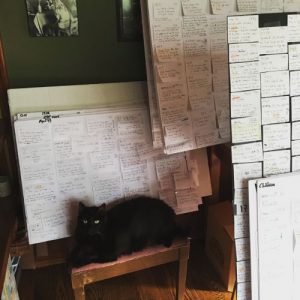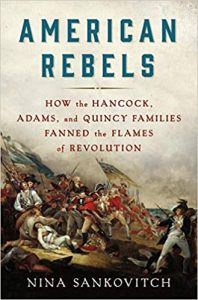Preparing to Write a Book is like Preparing to Cross An Ocean Alone
 I have written four books of nonfiction and a number of novels. For every book that I write, before I even start to write, I follow the same routine to prepare for the task ahead. My routine is an immersive process of research, organization, and outlining that gives me everything I need to begin writing – and even better, the fuel needed to follow through writing all the way to the end.
I have written four books of nonfiction and a number of novels. For every book that I write, before I even start to write, I follow the same routine to prepare for the task ahead. My routine is an immersive process of research, organization, and outlining that gives me everything I need to begin writing – and even better, the fuel needed to follow through writing all the way to the end.
My research, organization, and outline routine can be compared to what I would do before undertaking a solitary ocean crossing. To ensure a steady journey, I take the time to stock my boat with all the necessary supplies before heading out to sea. Writing can easily be compared to taking an arduous and lonely journey across an ocean with a definite definable coastline to be reached – although the actual port may differ from the one expected or aimed for.
The journey of writing is sometimes smooth sailing, sometimes rough and stormy – and sometimes so foggy and so murky that I have no idea where I am headed. But by relying on my bounty of supplies – my organized research and detailed outline – I can shine a beacon that cuts through the gloomy soup of uncertainty, blankness, and indecisiveness, lighting the way towards completing my book. Land ho! I bring vast treasures of previously unknown stories to your shore…
In order to illustrate my process, I’ll focus on my latest book, American Rebels: How the Hancock, Adams, and Quincy Families Fanned the Flames of Revolution. American Rebels grew out of my fascination with one specific question: how the heck did the American colonists have the courage to rebel against England, a nation known for its naval capabilities, military commanders, and empire-building (and crushing) abilities?
 In order to answer that question (and a bevy of other questions that rose up as I contemplated the first), I decided to find a community to study, one in which men and women from different social classes and backgrounds all made the decision, together or on their own, to rebel against England.
In order to answer that question (and a bevy of other questions that rose up as I contemplated the first), I decided to find a community to study, one in which men and women from different social classes and backgrounds all made the decision, together or on their own, to rebel against England.
I found just such a community in the small village of Braintree in the colony of Massachusetts. Hard to believe but major players in the fight for American Independence all came from Braintree, including John Hancock, John Adams, and even Abigail Smith Adams, who spent a significant portion of her childhood there.
My research for the writing of American Rebels followed two pathways: the timeline of events that gave shape to the period, and the personal and collective experiences of the men and women during that period. I wanted to find out not only what they thought about the times in which they lived and how they coped with the troubles, but also what they ate, what they saw (and what they looked like); what they smelled (and what they smelled like); and what they hoped for and what they lost, what they mourned, and how they rejoiced.
Key to My Research: Writing Everything Down
During the research phase of any new book, I take pages and pages of notes detailing what I discover during all steps of the process. Those steps include: visiting historical sites; reading through secondary sources (books relevant to my topic); or going through primary sources such as letters, diaries, sermons, pamphlets, posters, newspapers and periodicals, birth/death registries, wedding registries, property documents, official maps, voting registrars, public notices, and governmental advisories.
 While site-visiting or reading through books and documents, I write down every interesting fact that I discover. I remember things best – absorb them, really – by writing them down by hand. Simply reading and underlining pages in a book or a copied document is not enough, nor is taking a photograph or scanning the page for digital recovery. For me, I must write to remember.
While site-visiting or reading through books and documents, I write down every interesting fact that I discover. I remember things best – absorb them, really – by writing them down by hand. Simply reading and underlining pages in a book or a copied document is not enough, nor is taking a photograph or scanning the page for digital recovery. For me, I must write to remember.
As my research progresses, I copy all of my handwritten notes into marble notebooks organized by date, subject, or theme. One notebook is devoted to a timeline of events, while other notebooks are assigned to each person covered in American Rebels, and various themes that loop throughout their stories.
After I have completed most of my research (it is a process that continues right until the book is published), I transcribe all my notes from the marble notebooks onto notecards which I arrange onto large poster boards organized largely by date (relying on my timeline notebook to make sure I am not forgetting any event I want to include) but also by theme, (such as, in the case of my most recent book, “mob rule,” “loyalist versus rebel,”, etc). I also make a poster detailing all relevant family trees and connections. From these poster boards I then write out a simple outline of the book I hope to write. With my poster boards and outline completed, and my notebooks and handwritten notes close at hand, I can then begin to write.
Return to the Outline and the Organized Research to Get Back on Track
Whenever I found myself stuck in the writing of American Rebels and not sure where to go next, I first consulted my outline, and then returned to my poster boards to once again find my place in the story I was trying to tell. Or I spent an evening with one of my marble notebooks, finding in my scrawled notes the inspiration I needed to get back to writing the story I wanted to tell. The research was the foundation to which I returned again and again, and which allowed me to complete American Rebels.
—
Nina Sankovitch is a bestselling author, avid historian, and voracious reader. Her latest book is American Rebels: How the Hancock, Adams, and Quincy Families Fanned the Flames of Revolution (St. Martins Press, March 2020). In addition to being profiled in the New York Times (twice), she has written for the New York Times, the LA Times, the Huffington Post, and other media, and blogs on Medium. She lives in Connecticut with her family.
Find out more about her on her website http://www.readallday.org
Follow her on Facebook https://www.facebook.com/NinaSankovitchAuthor/
Twitter https://twitter.com/readallday
American Rebels: How the Hancock, Adams, and Quincy Families Fanned the Flames of Revolution
 A chronicle of the Adams, Quincy and Hancock families and how they helped spark the American Revolution.
A chronicle of the Adams, Quincy and Hancock families and how they helped spark the American Revolution.
Everyone recognizes John Hancock’s signature at the bottom of the Declaration of Independence but Nina Sankovitch’s American Rebels explores for the first time the family and community connections that led to it.
Sankovitch examines the intertwined lives of John Hancock, John Adams, Josiah Quincy Jr, Abigail Smith Adams, and Dorothy Quincy Hancock, and argues for the distinct roles each played in fomenting revolution.
Their trajectory from loyal British subjects to American rebels was forged in childhood; and their deeply held convictions, founded in community, fueled their collaborations during the fraught and violent years leading up to the signing of the Declaration of Independence in July of 1776.
Sankovitch presents in vivid detail, backed up by extensive and new research, the ties that bound these men and women together (including faith, love, ambition, and envy) and drove them to rebel against England, while also demonstrating how the desire for independence cut across class lines, and how families could be divided, rebels versus loyalists, in pursuing commonly-held goals of opportunity, liberty, and stability.
Category: On Writing
























